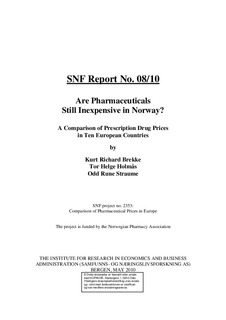| dc.description.abstract | In this report we compare prices of pharmaceuticals between Norway and nine Western European countries (Austria, Belgium, Denmark, Finland, Germany, Ireland, the Netherlands, Sweden and United Kingdom). The purpose is to examine whether pharmaceuticals are more (or less) expensive in Norway than in comparable countries and thus whether there could be any gains of “importing” foreign price levels.
To analyse the cross-country price levels we have obtained data from IMS Health for all prescription bound pharmaceutical sales of the 300 most selling (in sales value) substances on the Norwegian market for Norway and the nine reference countries. The data cover the first six months in 2009 and contain information on prices at both wholesale level (AIP) and pharmacy level (AUP), as well as sales volumes, manufacturer, product name, dosage, presentation form, etc.
Based on these data we compute bilateral price indices (products common to Norway and a given reference country) and global price indices (products common to all countries). The price indices are calculated separately for on-patent and off-patent substances, as well as for substances subject to reference price (trinnpris) regulation in Norway. We employ two different approaches. First, we compare prices of similar packages. We pick the most selling package in Norway and compare the price of this one with the same package (same pack size and dosage strength) in the reference countries. Second, we compute average substance prices, where we weight prices of each product with their sales. While the first approach yields a high degree of precision in the price comparisons, the second ensures a much higher degree of representativity. The main result is that Norway has among the lowest prices in Western Europe irrespective of whether we look at the overall index or the index for the patent or the generic market segment. For the substances under reference pricing (“trinnpris”) regulation, Norway has clearly the lowest prices. We also find that Norway has among the lowest pharmacy margins in the sample.
Finally, we analyse the development in prices from 2007 to 2009. Most countries have experienced price reductions over the period. The reduction in Norway is, however, fairly strong compared with the reference countries. Low prices and margins can be explained by the strict regulation of prices (and margins) in the on-patent-segment combined with competition stimulating incentives in the generic segment (trinnpris). These factors are also likely to explain why Norway is one of the cheapest countries in Western Europe when it comes to prescription drugs. | en |
